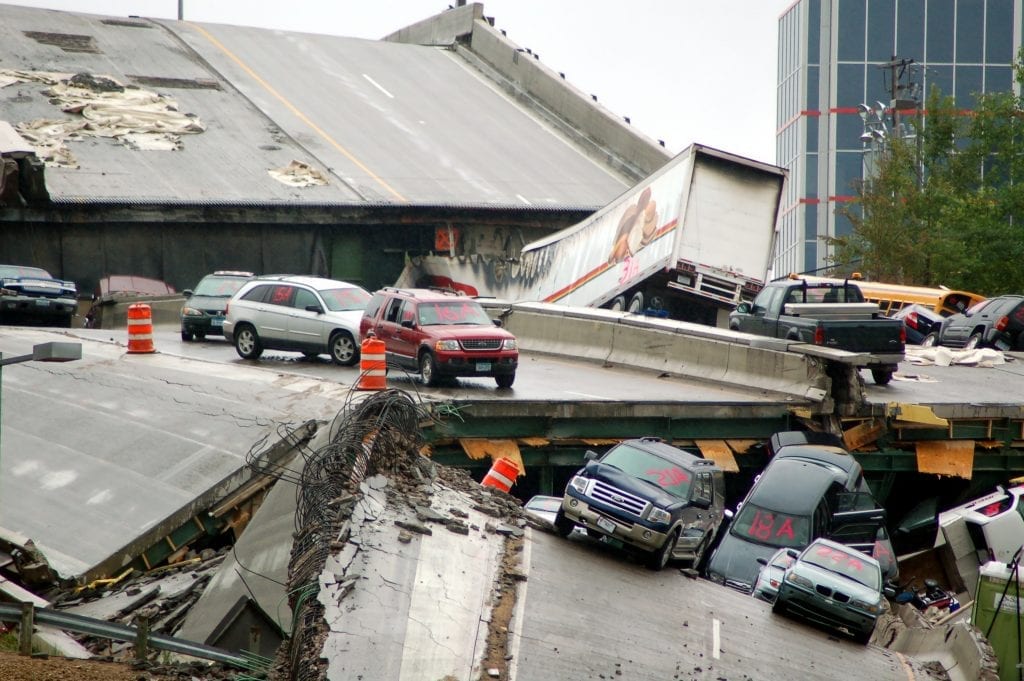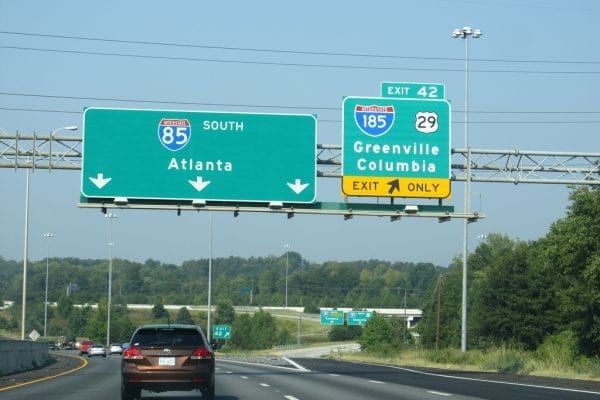When a portion of Interstate 85 in Atlanta collapsed on March 30, the entire world collectively gasped. Was it a terrorist attack, arson, deliberate sabotage? Was it aging infrastructure and a sign that our nation is dangerously behind on infrastructure updates?
While many details remain unknown, the evidence points to a combination of factors including a fire set by a homeless person, a lack of security around under-bridge storage, and the storage there of flammable materials. An investigation by the Atlanta Journal-Constitution discovered that the storage of similar materials under bridges is common around the state, along with a lack of documentation and security.
In May, that bridge reopened, and so far appears to be structurally sound. Its builder, C.W. Matthews, says that it’s one of the most inspected and safest bridges in the world. While Atlanta breathes a sigh of relief, the rest of the nation may want to take a closer look at their own bridges. Since 2000, at least 23 major bridges have collapsed in the United States alone, causing more than 40 deaths and even more injuries. This doesn’t count many smaller local bridges that collapse all over the country that never make national news. Here are five common causes of modern bridge collapse.
One: Natural disasters
Earthquakes and floods are a big problem, especially for older bridges that may have been built before modern requirements for duplicate safety measures. Bridges constructed before climate change began causing disruptions simply weren’t engineered for current extreme weather patterns.
Earthquakes damage bridges by shaking and causing structural damage. Flooding can cause just as much damage due to debris including trees and buildings that are lifted by the water and pushed forcefully against structural elements of the bridge. In both cases, parts of the bridge can crumble, crack, and wash away.
As an example, a railway bridge over Cedar River in Iowa collapsed in 2008, dropping 20 hopper cars filled with rocks into the river. Fortunately, no one was injured.
Two: Construction and Demolition Incidents
Many bridge collapses occur during construction or demolition. This may seem less dangerous than bridges collapsing with traffic on them, but these accidents can be even more deadly. During construction and demolition, dozens of workers may be on or under the bridge, far more than are usually present during normal use of the structure.
In 1907, a bridge in Quebec City came down during construction, due to unplanned weight at a critical point in the process. An onsite engineer is reported to have noticed the bridge beginning to deform, but his observations weren’t taken seriously. When the structure collapsed, it killed 75 workers and injured others.
Three: Design and Manufacturing Defects
If the world were made of Legos and therefore every building project alike, bridge construction could be perfected and perhaps bridges would never collapse. In the real world, every bridge project is different. The geology of the surrounding area, amount of traffic, local weather, available construction materials, and even desired aesthetics uniquely impact both design and construction. While lessons from other projects and from history can be applied, there is always opportunity for design and manufacturing errors to creep in.
In 1967, the Silver Bridge over the Ohio River in Virginia raised eyebrows when it collapsed after a supposed sighting of a mysterious creature, dubbed the “Mothman.” On investigation, however, the collapse turned out to be the result of a faulty steel eyebar. Over time, the eyebar corroded until it eventually failed. That collapse killed 46 people.
Four: Improper or Neglected Maintenance
The American Society of Civil Engineers rates the United States a stunningly low C+ rating for infrastructure maintenance and safety. This should raise eyebrows and anxiety levels for anyone who regularly travels America’s highways, especially if you live in an area with plenty of bridges. Lack of attention and maintenance allows deteriorating conditions to go unnoticed and problems to go unaddressed.
In 2013, the I-5 Skagit River Bridge in Washington collapsed under the weight of an oversized load. While the load was an immediate cause of the collapse, the bridge itself had been previously declared functionally obsolete, due to a lack of redundant structures and systems. Instead of repairing or replacing the bridge, officials chose to place weight restrictions, which were ignored, leading to the collapse. Remarkably, there were no fatalities, although three people were transported to the hospital with injuries.
Five: Fire
Once upon a time, fires were a common cause of bridge collapse. Before steel and concrete became more common and affordable, bridges were often built with wood. Train bridges, in particular were vulnerable as the friction of train wheels on rails caused sparks to sometimes ignite nearby materials.
Today, most bridges are constructed using steel and concrete, making fire damage a much rarer event. But, as we saw in Atlanta, that doesn’t mean it doesn’t happen. In that case, it took sabotage or extreme carelessness (nobody yet knows the motive) to start a fire, and that fire required a major source of fuel (flammable material stored under the bridge) in order to reach temperatures that caused the structure to weaken and collapse. As in this case, most bridge failures require a combination of factors.
It is very lucky that the Atlanta collapse caused no injuries, though most residents did not feel lucky in the following weeks, as they fought extreme traffic.
There’s a lesson in this for property owners, managers, and developers. Whether renovating or building new structures, it’s important to pay attention to structural soundness and safety. Like bridges, every new building and renovation is different. Just like bridges, geology, occupancy, use, and many other factors make each situation unique. It’s critical to carefully vet designers and GCs and ensure they are experienced, up to date on the latest codes, as well as the latest safe technology, materials, and construction techniques.
At GLE, we place safety first in all of our projects. Our proven track record gives our clients peace of mind. Contact us to to discuss your next project.




